The best drone that you can get right now is the DJI Mavic 2 Pro. Aside from the very similar Mavic 2 Zoom, no other drone on the market offers a better mix of performance and portability. Despite being highly compact and easy to throw in a backpack, the Mavic 2 Pro boasts some of the best specs and features in the biz — including a Hasselblad camera, omni-directional obstacle avoidance, and a flurry of automated flight modes. If you’re looking for a go-anywhere, film-anything drone that you can fit inside a backpack, then look no further.
That said, while DJI’s flagship is the best drone for most people, it’s certainly not the best drone for everyone — so we highly recommend checking out some of the other options on this list. No matter if you’re a pro filmmaker, an aspiring drone racer, or are just looking for a fun gift for you kid, you’ll find what you’re looking for below.
After something a bit different? Check out our collection of the best 2020 Black Friday drone deals.
At a glance
| Product | Category | Rating |
| DJI Mavic 2 Pro | Best drone overall | 4.5 out of 5 |
| Yuneec Breeze | Best drone for beginners | 3.5 out of 5 |
| Ryze Tello | Best cheap drone | In progress |
| DJI Inspire 2 | Best drone for filmmakers | 4 out of 5 stars |
| Uvify Draco HD | Best drone for racing | In progress |
| Parrot Mambo | Best drone for kids | In progress |
| DJI Spark | Best selfie drone | 4 out of 5 stars |
The best: DJI Mavic 2 Pro
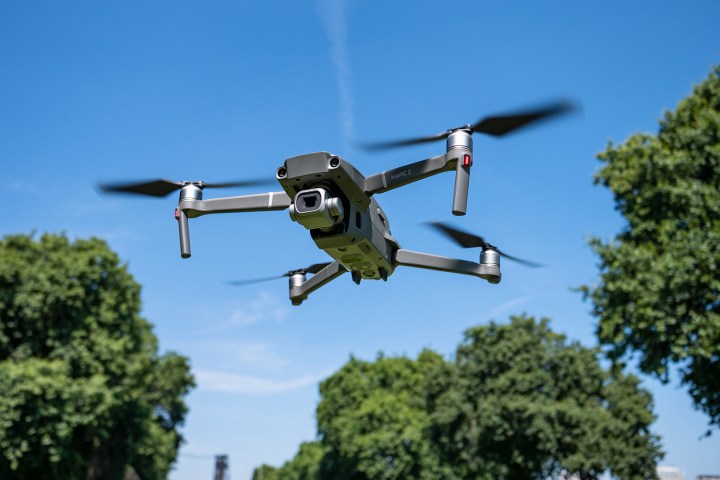
Why you should buy this: It has all the flight features you need in a drone, and a knockout camera from Hasselblad
Who it’s for: Anyone who wants to take really pretty pictures from the sky
How much it’ll cost: $1,449
Why we chose the DJI Mavic 2 Pro:
This drone seriously has it all. It’s powerful. It’s portable. It can dodge obstacles autonomously. And to top it all off, it has a camera that produces some of the best-looking aerial imagery we’ve ever seen. Truth be told, you can get a lot of these features in the original (and still very good) Mavic Pro, but the Mavic 2 Pro just does everything better.
For example, whereas the first generation Mavic Pro could only sense obstructions in front of itself, the Mavic 2 Pro is equipped with a full omnidirectional environmental awareness system. That means it can see forward, backward, upward, downward, and even left and right (although the latter two are only switched on in certain flight modes).
The Mavic 2’s camera also blows the previous generation out of the proverbial water (or maybe the air?). Thanks to its larger 1-inch image sensor and better processing tech, the Mav 2 Pro can capture 4K video in 10-bit color — which essentially means it can capture nearly a billion more discrete colors than its predecessor. It also has aperture control, which gives you far more control over exposure and depth of field.
All that, and the DJI Mavic 2 Pro is still nearly identical to the original in terms of size, shape, and weight.
Read our full DJI Mavic 2 Pro review
The best drone for beginners: Yuneec Breeze
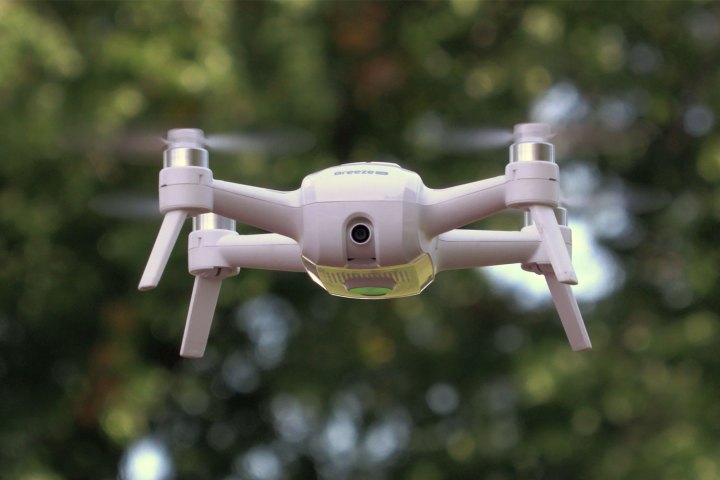
Why you should buy this: Because it’s easy to fly, relatively cheap, reasonably durable, and also provides you with plenty of room to grow and progress as a pilot
Who its for: Novice pilots who want a durable, easy-to-fly drone with a decent camera and a plethora of upgrade options
How much it’ll cost: $200-$230
Why we chose the Yuneec Breeze:
Some people will tell you that beginner pilots should cut their teeth on lower-end drones, but in our expert opinion, that’s nonsense. Why? Crappier drones are harder and less reliable to fly, which means that you’re far more likely to crash and destroy them. We think its a smarter idea to start out with a slightly nicer drone with reliable, responsive controls, a decent warranty, and a design that’s easy to repair or upgrade.
With these goals in mind, Yuneec’s Breeze is a fantastic choice for any greenhorn drone pilot. It is relatively cheap, but not so cheap that you’ll be encouraged to fly carelessly. It also has a pretty decent 4K camera on the undercarriage, and boasts an ultraportable form factor that makes transport, well, a Breeze.
And the best part? You can fly the Yuneec Breeze with your smartphone, or pick up Yuneec’s dedicated controller system if you want tighter, more responsive controls. In other words, if you start with this drone, you’ll be able to learn the ins and outs of piloting a quadcopter — but more importantly, you’ll also be able to upgrade your setup as your skills progress and your needs change.
Read our full Yuneec Breeze review
The best cheap drone: Ryze Tello
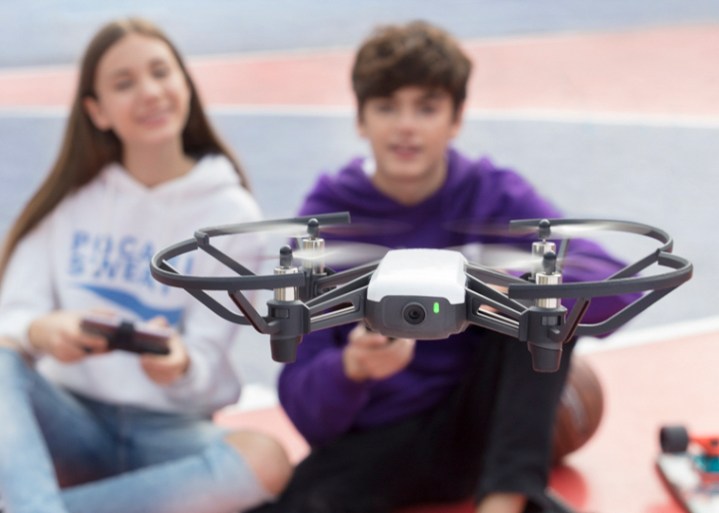
Why you should buy this: Despite costing just $99 bucks, this little bugger boasts all the essential features you need.
Who it’s for: Anyone who wants an affordable drone that’s easy to fly
How much it’ll cost: $99
Why we chose the Ryze Tello drone:
Generally speaking, drones that cost less than $100 bucks aren’t worth your time. They’re flimsy, they lack advanced features, and they’re almost always squirrely as hell in the air. But Tello is different. Despite the fact that it retails for only $99, it boasts a boatload of high-end features and functionality. Under the hood you’ll find a 14-core Intel vision processing chip, flight stabilization tech from DJI, a 5 megapixel camera capable of shooting 720p HD video, and a battery that gets you 13 minutes of flight time.
Unfortunately, the Ryze Tello doesn’t come with a controller, which means you’re forced to pilot Tello via virtual joysticks on a smartphone app: a control method that’s notoriously mushy and imprecise. The good news, though, is that Ryze built the drone with third-party peripherals in mind, so if you prefer to fly with physical sticks under your thumbs, you can pick up a GameSir T1d controller and link it to your bird. We think it’s well worth the extra $30 bucks!
The best drone for filmmakers: DJI Inspire 2
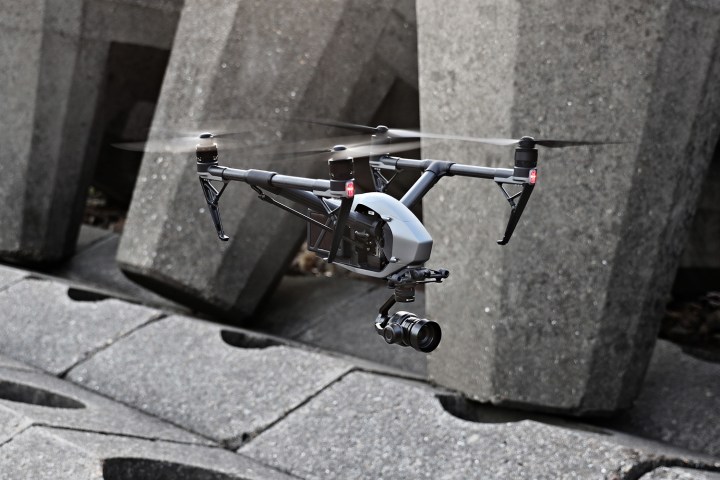
Why you should buy this: Because it’s a professional camera drone that’s ready to fly, straight out of the box
Who it’s for: Amateur and professional filmmakers who don’t want to build a custom camera drone rig
How much it’ll cost: $3,000
Why we chose the DJI Inspire 2:
There’s a reason you see DJI’s Inspire showing up everywhere from movie sets to Enrique Iglesias concerts — it’s a beast. The Inspire 2 boasts some seriously impressive specs: a controllable range of up to 4.3 miles, a top speed of 67 miles per hour, forward obstacle avoidance, and all the stabilization and autopilot features you could ever ask for in a drone. But the camera is definitely the star of the show.
DJI’s latest Zenmuse cam, the X5S, is a mirrorless Micro Four Thirds camera made specifically for aerial photography and cinematography. It shoots in 5.2K at 30 frames per second (or 4K at 60), takes 20.4 megapixel stills, and boasts a ridiculously wide ISO range of 100 – 25,600. As an added bonus, this rig is cradled inside a vibration dampened 3-axis gimbal, so your footage comes out silky smooth no matter how crazily you fly.
DJI’s control system is also fantastic. The revamped DJI Go app puts all of the Inspire 2’s advanced controls right at your fingertips. Shutter speed, aperture, and ISO can be adjusted with just a few taps, and focus can be set by simply tapping on the subject. With a setup like this, you don’t even need prior film experience or piloting skills to get professional-looking footage.
Read our full DJI Inspire 2 review
The best drone for racing: Uvify Draco HD

Why you should buy this: Because it’s ready to fly straight out of the box, but also modular and ready for upgrades
Who it’s for: Novice and intermediate racing pilots
How much it’ll cost: $699
Why we chose the Uvify Draco HD:
Uvify’s Draco HD racing drone wins our pick for the best racing drone for a few different reasons, but the first and most important is that it is modular and customizable. This means that you’re free to upgrade or swap any of the components (like the camera, the motors, the video transmitters, etc.) you’re free to. Don’t get us wrong — this sucker is outrageously quick and nimble even in its stock configuration, but being able to upgrade is crucial if you don’t want your racing rig to become obsolete in a year or two.
The other reason we love the Uvify Draco HD is that it’s not super complicated to fly or maintain, so it’s a great choice for beginners and pros alike. Even if you’ve never raced a drone before in your life, you’ll likely be able to learn the ropes with a Draco after just a few hours of practice. Alternatively, if you already have some FPV racing experience under your belt, you’ll feel right at home with this rig.
The best drone for kids: Parrot Mambo
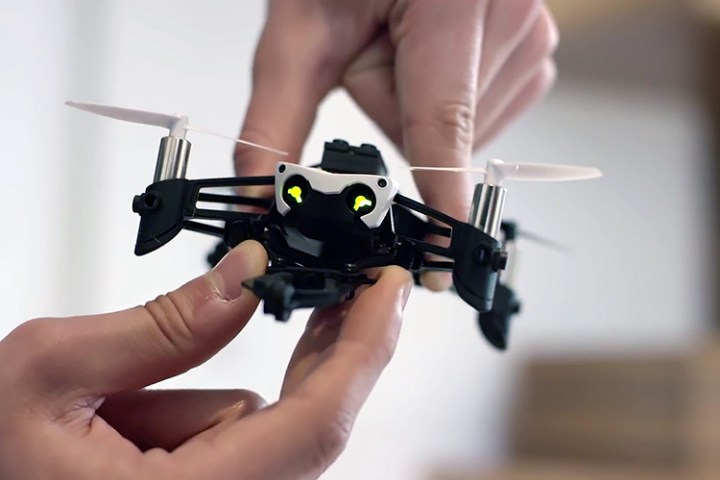
Why you should buy this: It’s stable and easy to fly, and it comes with a range of fun attachments.
Who it’s for: Kids and adults who want a drone that can shoot darts
How much it’ll cost: $120
Why we chose the Parrot Mambo:
Truth be told, you can get a cheaper drone that your kid will probably go bonkers over just the same, but they’ll actually be able to fly this one. There are a boatload of mini drones out there right now that you can get for under $50 — but in our experience, the vast majority of them are too squirrelly and difficult to master for your average kid.
Parrot’s new Mambo is different. Unlike most other mini drones, this one is actually designed specifically for kids. In addition to a boatload of motion sensors and advanced autopilot software that keeps the drone stable, Mambo also comes with a handful of attachments that make it more fun and engaging than a basic quadcopter. Inside the box you’ll find a cannon attachment, 50 foam cannon balls, and a grabber arm that can clamp and carry small objects.
And the best part? Parrot also gives you the option of piloting via smartphone or with a dedicated dual-joystick controller. The Flypad, as it’s called, is sold separately for $40 bucks, but it might be worth the extra dough if you don’t have a spare smartphone lying around and don’t feel like handing your kid your brand new iPhone every time he/she feels like flying the Mambo.
The best selfie drone: DJI Spark
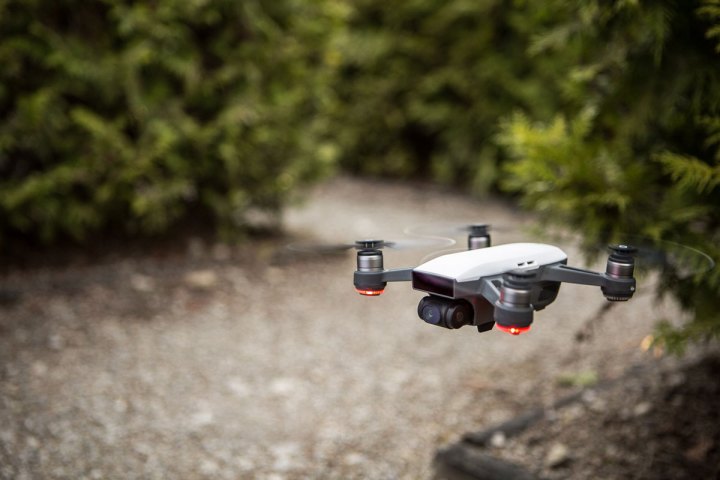
Why you should buy this: Because you want something portable that you can fly without a controller
Who it’s for: Anyone who wants to take epic selfies
How much it’ll cost: $500
Why we chose the DJI Spark:
If there’s one thing DJI is good at, it’s stuffing a ton of features and functionality into increasingly small drones — and nothing showcases this talent more than the Spark. Despite the fact that the drone’s hull is roughly the size of a Twinkie, DJI somehow managed to cram in many of the same goodies you’d find under the hood of the Spark’s bigger, bulkier, and more expensive brothers.
Aside from its tiny and hyper-portable design, the Spark’s biggest feature is arguably its plethora of intelligent flying modes. In addition to DJI’s standard stuff, the Spark sports a handful of brand-new modes, including Rocket, Dronie, Circle, and Helix (more on those in a moment). The drone also comes with gesture recognition abilities, which allow it to be operated without a smartphone or controller.
Another big addition is Spark’s obstacle avoidance system. While the ability to sense and avoid objects is usually a feature reserved for larger drones, DJI went ahead and built one into the hull of the Spark. It’s not quite as robust as what you’ll find on the Phantom 4, or even the Mavic Pro, but it still serves its purpose, and helps you avoid crashes.
Oh, and let’s not forget about the camera. In addition to a 12-megapixel camera that shoots video in 1080p at 30 frames per second, the DJI Spark also sports a two-axis gimbal. This lets it mechanically stabilize the camera and cancel out any jarring, shaky movements — resulting in smoother, better-looking footage. This also gives it a leg up on the competition; most selfie drones only feature single-axis mechanical stabilization.
Read our full DJI Spark review
How we test drones
Build quality & Design
the first thing we do when we get a new drone is beat it up a little bit. We don’t kick it down the stairs or anything, but we’ll give it a few knocks, twists, and shallow drops to assess the build quality and durability. Does it feel flimsy, or does it feel like it could survive a crash landing in the park? We give each review unit a light beating (and usually a couple unintentional crash landings) before we give you a definitive answer on how durable it is.
Flight performance, range, and autonomy
To gauge flight performance, we put the drone through a number of tests to see how the manufacturer’s claims hold up. First we take it to a local football field and see how fast it can clear 100 yards, then do some calculations to get an objective reading on speed in miles per hour. After that, we do a similar test to assess ascent and descent speeds, and all the while, we’re also taking notes on how responsive the controls are, how stable the craft is, how far it can go before it’s out of range, and what the overall piloting experience is like compared to other drones.
Battery life and charge time
After we’ve taken the drone out to play for a while and jotted down a few notes about how long the battery lasts, we put it on the charger and grab a stopwatch to determine recharge time. Then we take it back out and do a hover test. By flying the drone in the least demanding conditions, we can get a sense of what the maximum flight time is. And finally, we take it out a few more good, hard flights to find out how long the battery lasts (on average) under normal conditions.
Camera, accessories, and upgradability
If the drone we’re testing happens to have a camera capable of recording, we capture as much footage as we possibly can. We’ll shoot in dark places, light places, and places with lots of color and contrast. This footage is then compared to all the highlight reels that we filmed with other drones, which helps us get a sense of the camera’s strengths and weaknesses. We also test any accessories that accompany the camera, like lenses, filters, gimbals, or FPV goggles. Finally, we’ll also let you know if the camera setup is upgradable, so you wont be stuck with an outdated shooter in two years.
Editors' Recommendations
- Best drone deals: Get a cheap drone for $47 and more
- The 3 best (reputable) DJI Drone alternatives in 2024
- The 5 best laptops for photo editing and photographers
- Best microSD cards in 2023: top picks for your computer, camera, or drone
- The best 360-degree camera apps for iOS and Android




